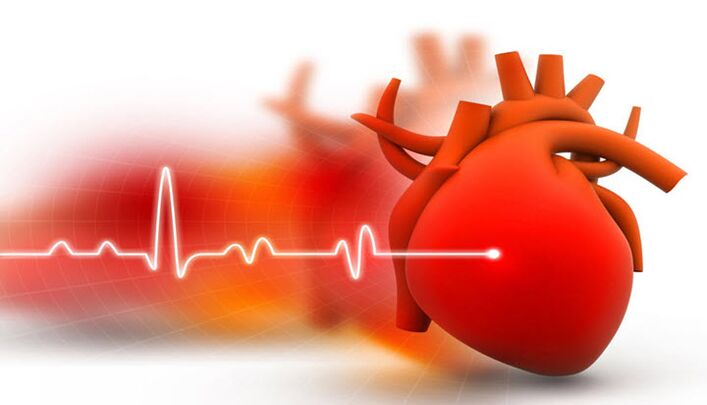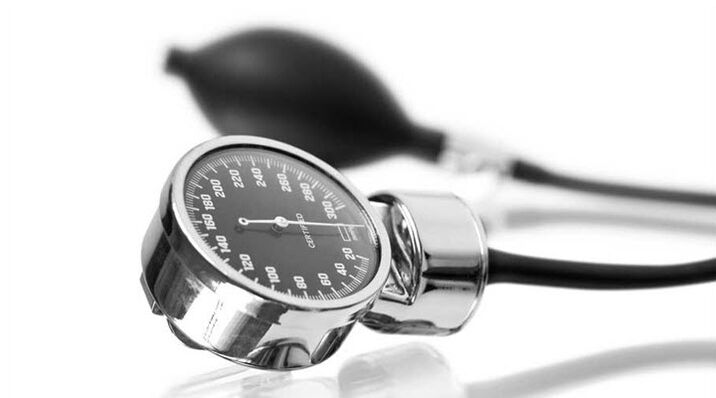According to medical statistics, high blood pressure is a frequently observed violation of the cardiovascular system. The development of high blood pressure negatively affects the blood vessels: it reduces flexibility, increases fragility. Such processes lead to internal bleeding. Persistently high blood pressure often leads to the progression of fatal pathological conditions: myocardial ischemia, myocardial infarction, or stroke.
Early diagnosis of high blood pressure, timely treatment allows the patient to avoid changes that could significantly worsen health indicators or lead to death. People over the age of forty and older should have their blood pressure checked regularly, have a blood pressure monitor at home, and seek medical help if they notice any other symptoms of the disease.
Causes of high blood pressure
What can cause high blood pressure in a person? What factors can provoke your progress? Such questions are still relevant and are asked by physicians interested in their health. Persistently high pressure levels can cause some changes in the way the human body works. The following diseases are affected:
- the condition of the blood vessels accompanying atherosclerosis;
- heart failure;
- diabetes;
- gout;
- rheumatoid arthritis;
- renal pathology.

Other factors also contribute to the development of high blood pressure. The cause of the disease is related to:
- heredity: pathologies are most susceptible to children whose parents have high blood pressure;
- age (over 45 years) and gender (men have higher morbidity rates);
- overweight and obesity for various reasons (dysfunction of the body, low mobility, consumption of foods high in animal fat, salt, regular overeating);
- injury to the skull and brain;
- cholesterol levels rose significantly from normal;
- hormonal changes in the female body during menopause;
- alcohol abuse, smoking, addiction to caffeinated beverages;
- complications after infectious or viral diseases;
- neglecting walks while staying indoors without fresh air.
High blood pressure accompanies patients in whom an unstable emotional state is the norm. Psychological discomfort, aggression or anger attacks, stressful situations, tragedies in personal life increase the value of indicators.
Classification and stages of the disease
Two methods are used to classify a hypertensive problem - according to etiology (cause of occurrence) and degree of development (stage).
In the event that the nature of high blood pressure cannot be reliably determined, the doctor will announce a diagnosis of primary (essential) hypertension. This is most common and occurs in 95% of patients. The remaining 5% of people have a secondary form of the disease, a further manifestation of other pathologies that requires therapy.
The three stages of the process differ in terms of symptoms and severity: mild, moderate, and severe.
Mild hypertension is characterized by an increase in blood pressure within the limits:
- systolic blood pressure between 140-159 mmHg. street;
- diastolic blood pressure between 90-99 mmHg. Art.
The course of the disease at this stage is not complicated by the pathology of the internal organs, it often occurs without pronounced symptoms.
With the average form of the disease, blood pressure values are in the range of 160-179 / 100-109 mmHg. Art. The patient's heart and kidneys start to suffer, the state of the retina changes, atherosclerotic plaques form in the vessels. In most cases, functional transformations take place unnoticed.
Severe tertiary hypertension combines diagnosable pathologies of the heart, brain, visual organs, vasculature, and blood pressure above 180/110 mm Hg. Art. There is a high risk of developing a hypertensive crisis

Typical symptoms
Initial and intermediate stage hypertension should not cause symptoms, which is a dangerous factor for the patient. The main symptoms that indicate the development of the condition are headache and dizziness. They often and for a long time accompany the patient, they occur due to spasms and narrowing of the cerebral vessels. Other signs are general weakness, tiredness, nausea, tinnitus, veil in mind.
A person with hypertension also feels other symptoms of high blood pressure:
- decreased vision, feeling of narrowing eyes;
- frequent nosebleeds;
- increased intracranial pressure;
- short-term loss of consciousness;
- instability of emotions, mood swings;
- development of insomnia;
- physical activity causes severe redness of the facial skin;
- vomiting for no nutritional reason;
- fast pulse and heartbeat;
- change or deterioration of memory;
- significant swelling of the limbs, the face.
Signs of high blood pressure during the severe development of the disease are accompanied by complications of the heart and blood vessels: heart failure, arrhythmia, angina pectoris, myocardial infarction. Symptoms of high blood pressure are combined with kidney failure, changes in the blood supply to the brain, microstroke, stroke.
The symptoms of hypertension may occur in different combinations in the patient, with different manifestations: stable, strong, single. The peculiarity of the disease is that a person is dominated by high blood pressure.

Diagnostics
If hypertension is suspected, a full examination of the patient provides sufficient grounds in three cases of increased blood pressure within one month. This symptom cannot be ignored.
It is recommended that the patient measure independently with a tonometer several times a day and record the results. Under the conditions of a medical institution, a diagnostic method such as daily monitoring of blood pressure is used. The instruments record day (every 15 minutes) and night (twice an hour) pressures.
Clinical blood and urine tests assigned to the patient make it possible to determine the change in the body's functions. Cholesterol, protein, potassium, calcium, glucose, hemoglobin, and lipid spectra are important in diagnosing the disease.
The presence of signs of high blood pressure and high blood pressure is indicated by a malfunction of the heart muscle. The following methods are used to study it:
- auscultation - using a stethoscope they listen to the sounds made by the organ, observe the rhythm of their work;
- ECG - decoding an electrocardiogram from a patient allows a detailed assessment of heart function over a period of time;
- ultrasound and echocardiographic diagnostic methods reveal defects of the heart muscle and valves, allow the correlation of the size of the atria and ventricles;
- Doppler examination allows the condition of blood vessels to be assessed;
- arteriography - the results of the monitoring inform about the changes in the walls of the arteries, their damage, the location of the cholesterol plaques.
In case of suspicion of hypertension, examination of the fundus, ultrasound diagnosis of the kidneys and renal arteries, adrenal glands are prescribed.

Therapeutic measures
Treating high blood pressure involves the use of medications that are able to maintain normal pressure. In cases where a secondary form of the pathology develops, therapy involves relieving the disease, which is the cause of the increase in pressure in the patient.
List of medicines
Eliminating high blood pressure will help you take your medication as directed by your doctor. The first degree of hypertension does not require medical treatment, and the patient is advised to change their lifestyle and change their usual diet. Moderate and severe forms of the disease should be controlled with the following groups of drugs:
- diuretics (thiazides) contribute to the natural absorption of fluid accumulated in the patient's tissues, reduce swelling, which increases the permeability of blood vessels;
- beta-blockers correct your heart rate;
- sartans - a single intake of the funds can normalize blood pressure, keeping the result for one day;
- calcium antagonists correct heart function, prescribed for severe angina, arrhythmias;
- inhibitors of angiotensin-converting enzyme dilate blood vessels, prevent seizures;
- Alpha-adrenergic blockers improve the condition of peripheral blood vessels.
The doctor will prescribe a certain medication or a combination of these for each patient, taking into account the general condition of the patient and the comorbidities.
First aid at home
Uncontrolled increases in blood pressure are not uncommon in patients with hypertension. In the event of a sudden deterioration in your condition, relatives are advised to call an ambulance immediately. The following steps must be taken before arrival:
- eliminate panic in hypertensive patients, calm down: the stressful situation helps to increase blood circulation, increase pressure;
- taking herbal sedatives (Corvalol, motherwort, catnip) can improve the condition;
- it is important to place the person comfortably, it is recommended to sit, lean, relax in a comfortable position;
- apply a cold compress to the front while keeping the feet warm (you can use warming pads or mustard patches);
- you need to take the medicine recommended by your doctor urgently;
The first aid process is accompanied by the removal of blood pressure monitors (every 10 minutes), the results of the measurement should be recorded in writing and the sheet should be handed over to the doctors.
General prevention tips
Preventing high blood pressure consists of a series of measures. Doctors give advice on how to change your lifestyle, diet, and use folk experiences to normalize the condition.
The health institution draws attention to the extraordinary dangers of alcoholic beverages and smoking for hypertensive patients and recommends that they be stopped. Moderate physical activity, loose walks in nature, easy work can be seen.
Improving the condition of patients contributes to the transition to a special diet. Avoid pickles and smoked meats, fried foods, fatty meats, and do not eat fresh bread. Vegetables, fruits, herbs, dietary meat and dairy products, cereals (rice, buckwheat), legumes should be the main ingredients of the new menu. Patients should consume limited amounts of salt, sugar and fluids.
Long-known folk treatment methods do not allow the pressure to rise. Infusions and decoctions based on herbs, bee products, vegetables or nuts and other ingredients are individually selected in the desired proportions.



























